Kevin Smith and Yu Rong Zhou
Published: 1 Aug 2016

CTN Issue: August 2016
A note from the editor:
This month we take a look at the optical transmission that without which all of the fancy wireless systems would not be able to access the internet. The bandwidth pressure on the optical backbone will be at least as intense as it is on the wireless access. But never fear, the engineers in this area are also making strides. So this month we hear from Kevin and Yu Rong at British Telecom on their recent successful trial of a 3Tb/s super channel, as well as some of their thoughts on the future for optical networking. As always, your comments are welcome.
Alan Gatherer, Editor-in-Chief
Optical Transmission Innovation for Long Term Broadband Internet Growth
Kevin Smith and Yu Rong Zhou
1. Introduction
Data traffic growth continues to rise exponentially driven by the ever increasing demands of bandwidth intensive applications, such as IP video and TV, enabled by the widespread roll-out of higher speed fibre-based broadband and 4G/5G mobile access technologies. Such traffic growth places massive demands on our core networks and, in particular, drives the need for innovative solutions to ensure that the underlying optical fibre infrastructure can carry the resulting high capacities efficiently and cost effectively. Currently, to meet these capacity demands, polarisation multiplexed 100 Gb/s wavelengths (QPSK) based on coherent optics have become the defacto standard for deployment [1]. In this article, we describe the key technologies that allow us to scale beyond these current speeds, significantly increasing the optical fibre capacities whilst ensuring increased spectral efficiency and thereby a more cost effective optical infrastructure. We also describe results from our recent trials and live deployments that pave the way for BT’s future Terabit optical infrastructures, and give us good confidence that our core optical network can scale gracefully to accommodate future growth in IP based traffic.
2. Key Innovations Enabling High-Speed Terabit Optical Transmission
The key concepts behind scaling optical channels towards Tb/s speeds and capacities are illustrated in figure 1(a), where we show the three basic degrees of freedom that we have at our disposal; (i) Baud-rate (or symbol rate), (ii) modulation format (e.g. QPSK, 16-QAM) and, (iii) the number of optical channels required to form the desired capacity. In recent years, there has been significant research and development and exploitation of advanced modulation format signals (e.g. QPSK, 16-QAM) as well as variable Baud-rates (e.g. 32, 48, 64 GBaud), in order to increase the bit-rates of the individual channels generated in coherent optical transponders. Each of these different formats has its own trade-offs and the best choice depends specifically on the rate and reach required as well as the desired operational margin [2]. The most advanced production grade, real-time transponders now operate with flexible modulation formats and symbol rates as high as 64GBaud [3].
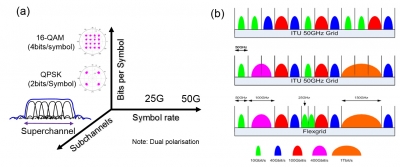
The third degree of freedom relates to the number of optical channels that are required to form the desired capacity. Current optical DWDM transmission systems rely on fixed grid filters to allocate the available spectral bandwidth, typically in lumps of 50GHz. As illustrated in figure 1(b), these fixed chunks of optical spectrum can be extremely limiting both in terms of supporting higher speed optical channel bandwidths, as well as restricting how closely optical channels can be spaced and thereby limiting the number of optical channels that can be carried over a single optical fibre. Typically, supporting a maximum of 80-90 wavelength channels across the C-band amplifier window (~1530 - 1565nm). Figure 1(b) also shows the potential of new flexible grid based structures which do not restrict the optical channel bandwidths and spectral allocation and thereby can support higher speed channels such as 400Gb/s as well as improve spectral efficiency by squeezing optical channels more closely.
In this new ‘gridless’ regime, the concept of an optical channel is no longer a single wavelength, instead we can define a single capacity entity comprising multiple sub-channels which together form an aggregate optical capacity often referred to as a ‘superchannel’ which can be configured and managed across the optical network. As described above, depending on the rate and reach requirements, a given superchannel capacity can be implemented in different ways. For example, we could realise a 400G superchannel using (a) 4 x 100Gb/s sub-channels for long reach, (b) 2 x 200Gb/s sub-channels for medium reach or even, (c) a 400Gb/s single carrier for short reach and most spectrally efficient application.
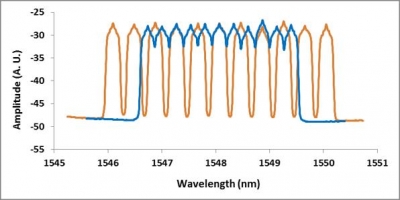
Figure 2 shows two experimentally demonstrated configurations of a 2.2Tb/s superchannel comprising 11 x 200G (16-QAM) sub-channels with differing channel separations. In the first case (red curve) the 11 sub-channels are shown with conventional 50GHz separation and in the second case (blue curve) the sub-channels are squeezed together to as little as 33.5GHz. The spectral efficiency advantage of the narrower 33.5GHz spacing is clearly visible with a spectral efficiency saving of ~49% [4]. Compared to the standard 50GHz grid, this now implies ~120 channels across the C-band.
3. Real-World Technology Trials and Deployment Experiences
In this section, we summarise our recent real world experiments and technology trials exploiting these new high-speed Terabit technologies. Figure 3 shows results from our successful error-free transport of up to 3Tb/s superchannels over a fully managed field installed flexible grid link between BT’s Adastral Park R&D laboratories, Ipswich and the BT Tower (and back) [4]. Figure 3(a) shows the 3Tb/s superchannel (15 x 200G 16-QAM sub-carriers) using real time, production grade hardware and software, running over the 359km field installed G.652 single mode fibre and DWDM system. The optical superchannels, which co-propagate with conventional 50GHz 100G channels, were configured and managed from BT’s live Transmission Network Operations Centre (TNOC) in Cambridge.
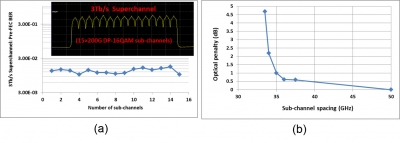
Very significantly, the measured pre-FEC BERs (<7 x 10-3) are plotted and confirm very consistent and robust optical performance of all the component optical sub-channels. Figure 3(b) also shows the measured optical penalty (in dB) for long term error free operation, down to subcarrier spacings as low as 33.5GHz which ultimately demonstrates a spectral efficiency of 5.97bits/s/Hz, more than 49% improvement over conventional 50GHz grid (as illustrated in figure 2). Very little optical penalty (<~1dB) was observed down to channel spacings of 35GHz. These are key results and strongly validate the expected capacity enhancement benefits of flexible grid in a real world and practical environment.
Experimental measurements also clearly demonstrated the potential of the real-time 200Gb/s 16-QAM channels for long term optical performance stability in a further 400G (2 x 200Gb/s 16-QAM) live upgrade trial in a BT (standard 50GHz grid) DWDM link between Belfast and Dublin. The optical link used standard G.652 single mode fibre, over a total distance of 183km and multiple ROADM nodes. Live customer traffic was present on the link via 10Gb/s, 40Gb/s and 100Gb/s wavelengths. During the trial period of more than 2 months, the performance of the 400G channels was monitored with robust long term error free performance observed [4,5].
Our most recent technology trials have focussed on the development and exploitation of industry leading highest Baud-rate (64GBaud) real time optical transponders. 64GBaud technology opens up new attractive options for longer reach 200Gb/s single carrier solutions, using, for example, QPSK modulation, rather than the more standard 200G 16-QAM approach. The driver for this new long reach capability will become apparent when we later introduce our latest results and early deployment of flexible grid and superchannels between London and Dublin. Figure 4 shows a 5.6Tb/s superchannel successfully transported over our 359km fully managed flexible grid optical link between Adastral Park and London, where the superchannel comprises up to 28×64GBaud 200Gb/s QPSK sub-channels. Each sub-channel has a ~60GHz 3dB spectrum width and is separated from its neighbours by 75GHz, giving a total spectral width of 2.1THz. Again, we plot the measured pre-FEC BERs (~4x10-5) and confirm error free and very consistent optical performance for all the optical sub-channels. The measured pre-FEC error rates (more than 2 orders of magnitude better than the 200Gb/s 16-QAM shown in figure 3(a)) are consistent with the higher optical margins required for a longer reach 200Gb/s single carrier solution.
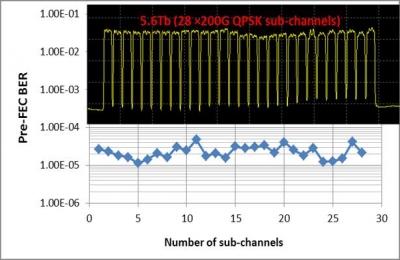
Figure 5 shows a schematic diagram of our live flexible grid link between London and Dublin. The link uses Huawei OSN8800 equipment, and has a total distance of 727km with 4 flexible grid ROADM nodes and 10 spans of G.652 fibre including an unrepeatered undersea cable of 133km. EDFA amplifiers are used along the link except for the undersea fibre span, where the hybrid Raman and EDFA amplifiers improve the noise performance over this long span. The Huawei OSN9800s located in London and Dublin house the 12 64GBaud optical transponder ports which generate 12 optical sub-channels. The optical sub-channels support multiple, software configurable modulation formats, including 200G QPSK, 200G 16-QAM and 100G QPSK. The optical superchannels are then added to the link via the flexible grid ROADMs together with 40Gb/s and 100Gb/s live traffic [3].
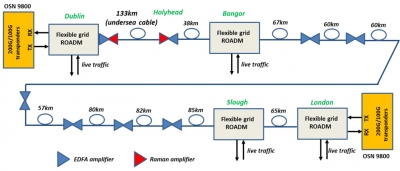
Key results are shown in figure 6(a), where we illustrate a real-time 2Tb/s superchannel (10 x 200G QPSK sub-channels) together with 200G 16-QAM and 100G QPSK channels, all running error free alongside live customer traffic over the 727km link. Figure 6(b) shows a 16 hour continuous (overnight) pre-FEC BER measurement for all 12 of the 64GBaud channels (10x200Gb/s QPSK, 1x200Gb/s 16-QAM and 1x100Gb/s QPSK) and demonstrates stable, long term error free performance of all channels. We clearly see the enhanced 200G performance of QPSK over 16-QAM format, further demonstrating the longer reach capability of 200Gb/s 64GBaud QPSK, thereby eliminating the need for costly regeneration and ensuring a lower latency link than would result from using the 16-QAM format.
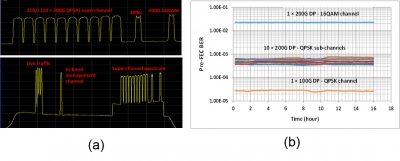
4. The Future
We have described the key enabling high-speed Terabit optical technologies that will allow us to scale our core optical transmission networks to meet the anticipated bandwidth demands of IP based traffic growth. So far, our real world, industry leading trials and early deployment experiences give us good confidence that our networks can scale gracefully to meet these demands. However, we cannot be complacent and we need to continue to innovate to mine further capacity from our optical fibre infrastructures. Critical in guiding our thoughts in this matter, we need to make sure that we can continue to cost effectively maximise the capacity potential of our existing optical fibre infrastructures. As well as exploring the feasibility and applications of flexible, higher order modulation formats and Baud-rates, we should also consider the extension of optical spectrum beyond the standard C-band to, for example, combined C- and L-band amplification. Ultimately, we should also explore the application of new optical fibre structures, optimised to support higher speed optical transmission, for example, fibres with lower loss and larger cores.
With the potential for ever increasing optical fibre capacities, there rapidly follows a strong business imperative to ensure that our future optical networks are extremely reliable and always available. This requirement drives a critical need for innovation in the areas of optical capacity protection, restoration and resilience [6]. In general, we are seeing that flexibility and agility are becoming increasingly important features and network differentiators; with applications including finer granularity capacity provisioning, making more flexible and efficient use of available spectrum and optical margin, as well as the potential for new applications related to provisioning bandwidth on demand. Such developments not only help ensure that our future high-speed Terabit transmission systems can cost effectively scale to meet capacity growth with high ‘always on’ reliability and availability, as well as enable us to offer the potential for new customer focussed services.
References
- K. Roberts, ‘100G – key technology enablers of 100Gbit/s in carrier networks’, paper NWA1, OFC/NFOEC 2011
- G. Bosco, V. Curri, A. Carena, P. Poggiolini and F. Forghieri, “Performance of Nyquist-WDM Terabit Superchannels Based on PM-BPSK, PM-QPSK, PM-8QAM or PM-16QAM Subcarriers”, Journal of Lightwave Technology, Vol. 29, No. 1, January 1, 2011, page 53 – 61
- Y. R. Zhou, K. Smith, S. West, M. Johnston, J. Weatherhead, P. Weir, J. Hammond, A. Lord, J. Chen, W. Pan, C. Cao, R. Yang, N. Zhou, and S. Wu, “Field Trial Demonstration of Real-Time Optical Superchannel Transport up to 5.6Tb/s over 359km and 2Tb/s over a Live 727km Flexible Grid Link using 64GBaud Software Configurable Transponders”, OFC post-deadline paper Th5C.1, OFC 2016
- Y. R. Zhou, K. Smith, R. Payne, A. Lord , J. Hopewell, J. Weatherhead, J. Chen, J. Yao, W. Liu, C. Zhao, Y. Xiong, Z. Xiao, and P. Du, “Field Demonstration of up to 3Tb/s Real-Time Superchannel Transport over 359km Using a Fully Managed Flexible Grid Infrastructure with Net Spectral Efficiency of 5.97bit/s/Hz”, Journal of Lightwave Technology (Invited), vol.34, no.2, January 2016, pp.805 – 811
- Press announcement “BT and Huawei successfully complete 400Gbps core network trial”: https://www.btplc.com/BTToday/NewsList/BTandHuaweicomplete400Gbpstrial/index.htm
- Y. R. Zhou, K. Smith, P. Weir, A. Lord, J. Chen, W. Pan, N. Zhou and Z. Xiao, “Field Trial Demonstration of Novel Optical Superchannel Capacity Protection for 400G Using DP–16QAM and DP–QPSK with In-service OTDR Fault Localization”, paper W3B.3, OFC 2016
Statements and opinions given in a work published by the IEEE or the IEEE Communications Society are the expressions of the author(s). Responsibility for the content of published articles rests upon the authors(s), not IEEE nor the IEEE Communications Society.


